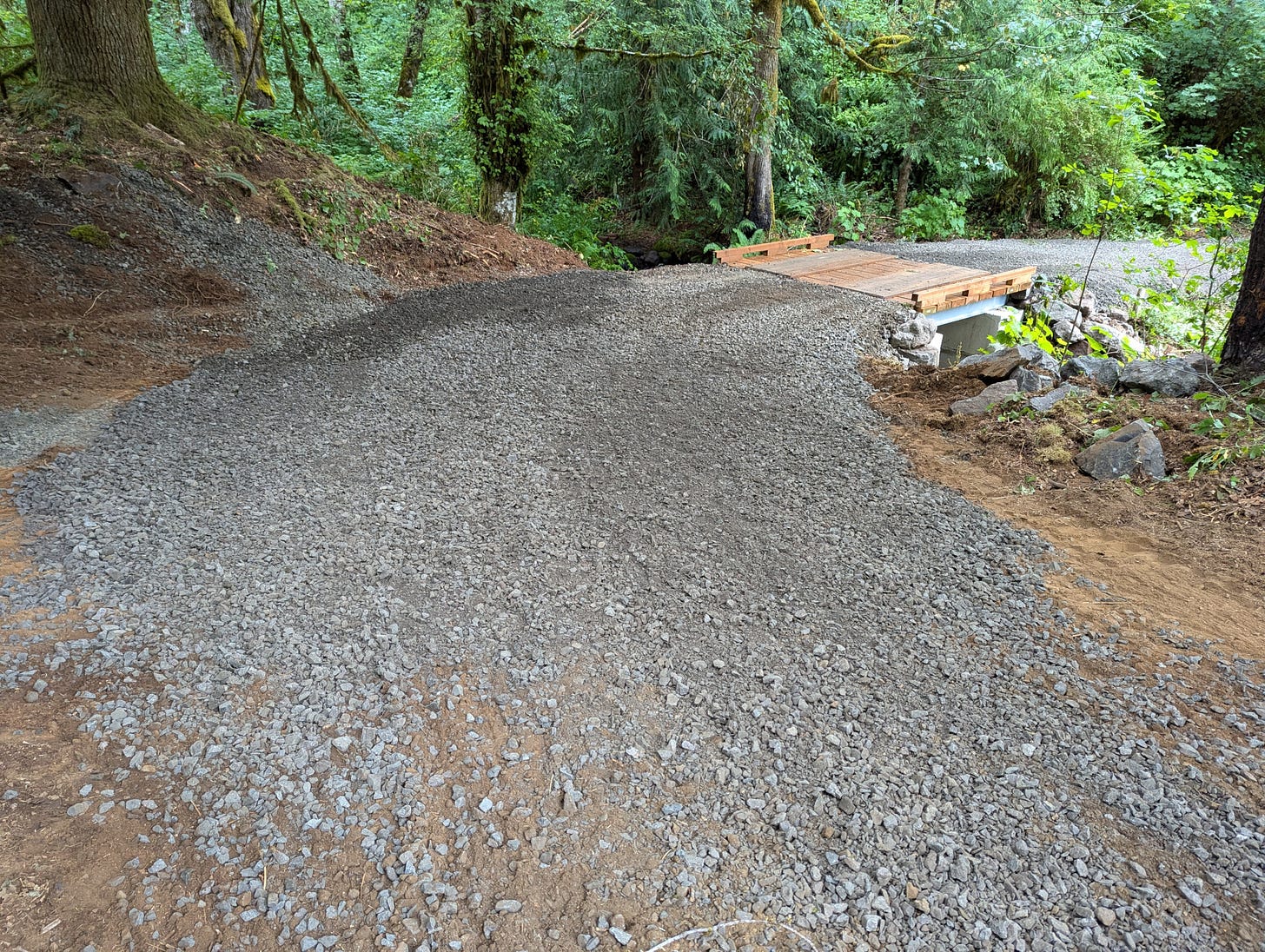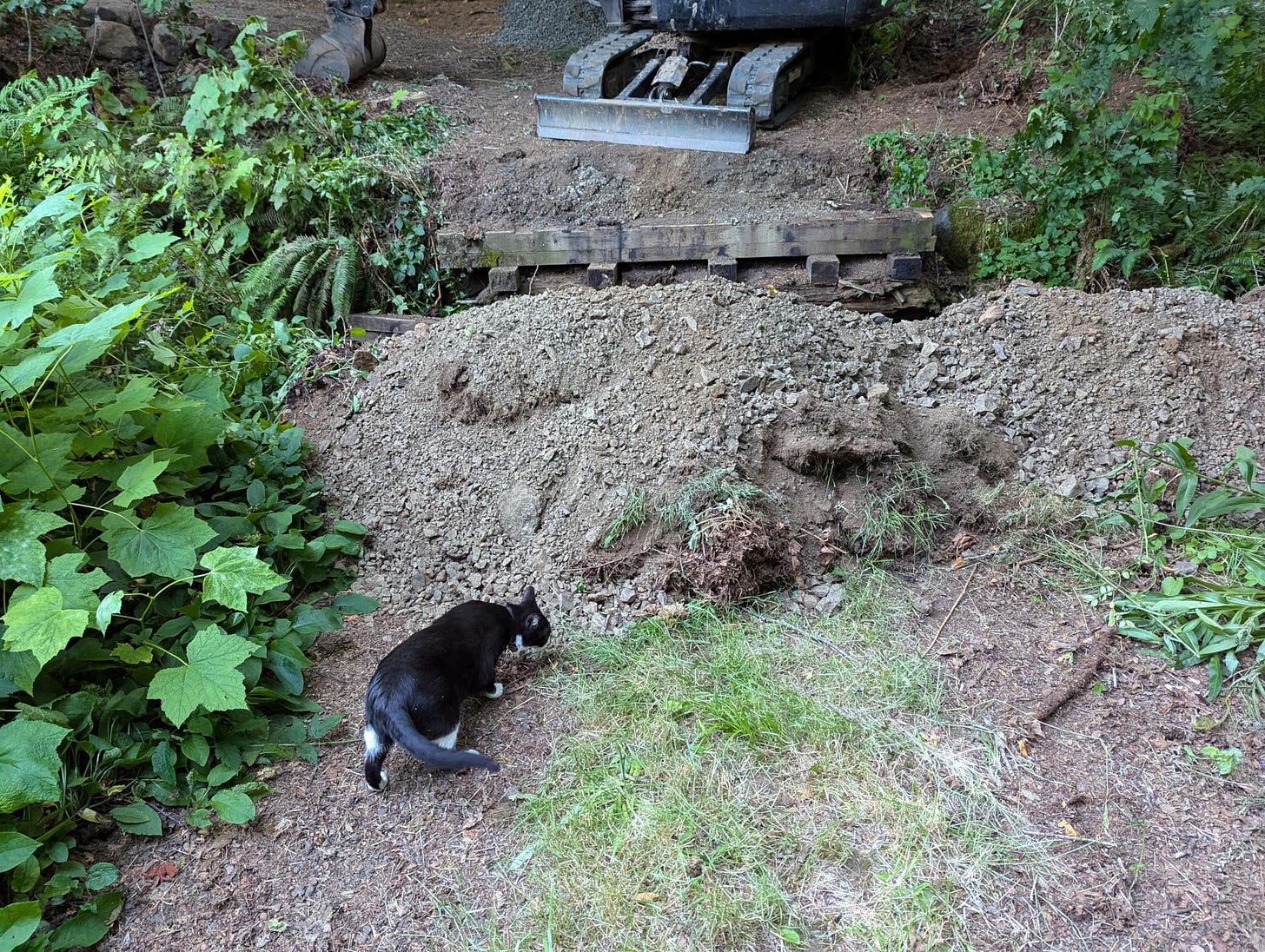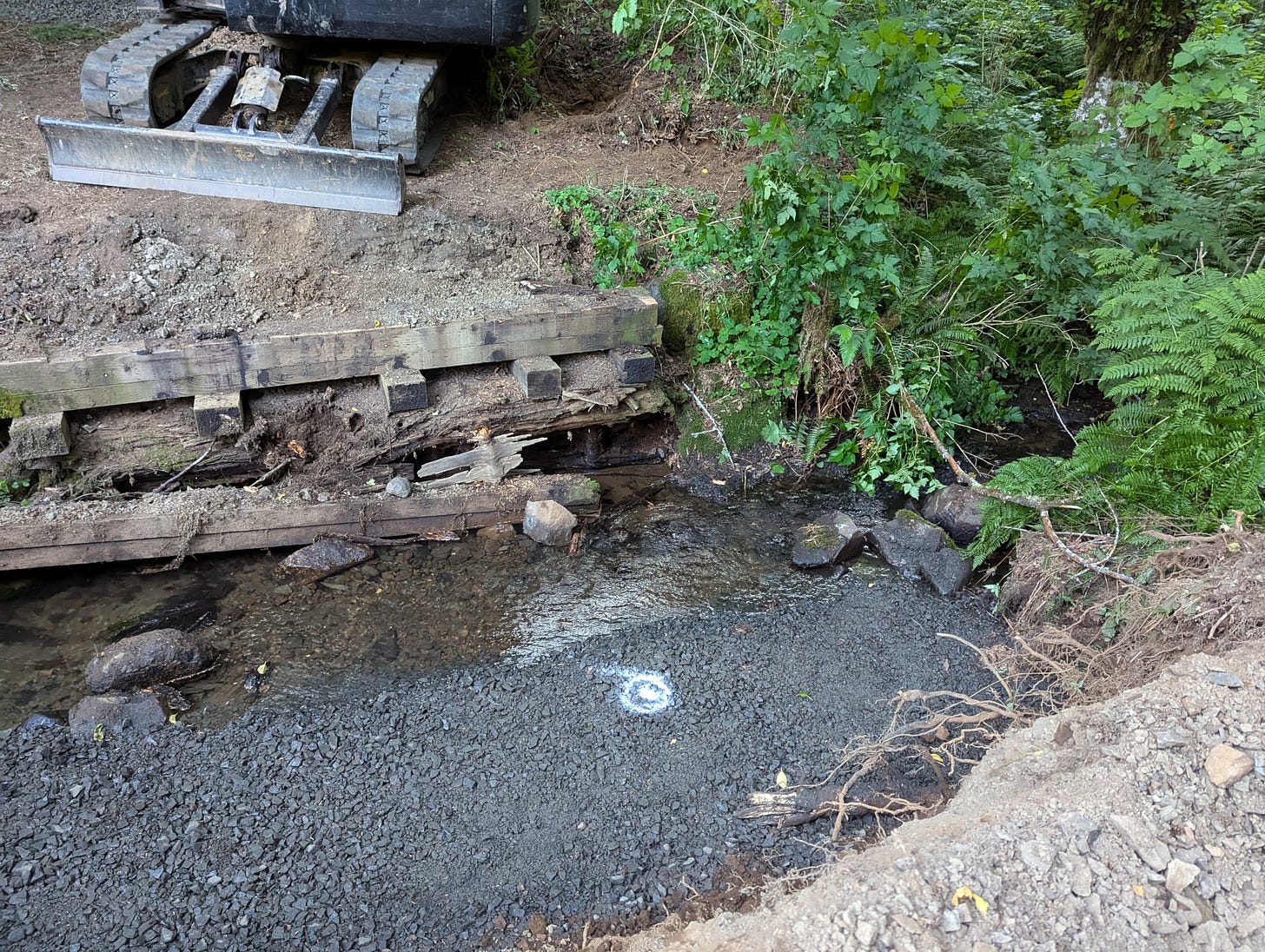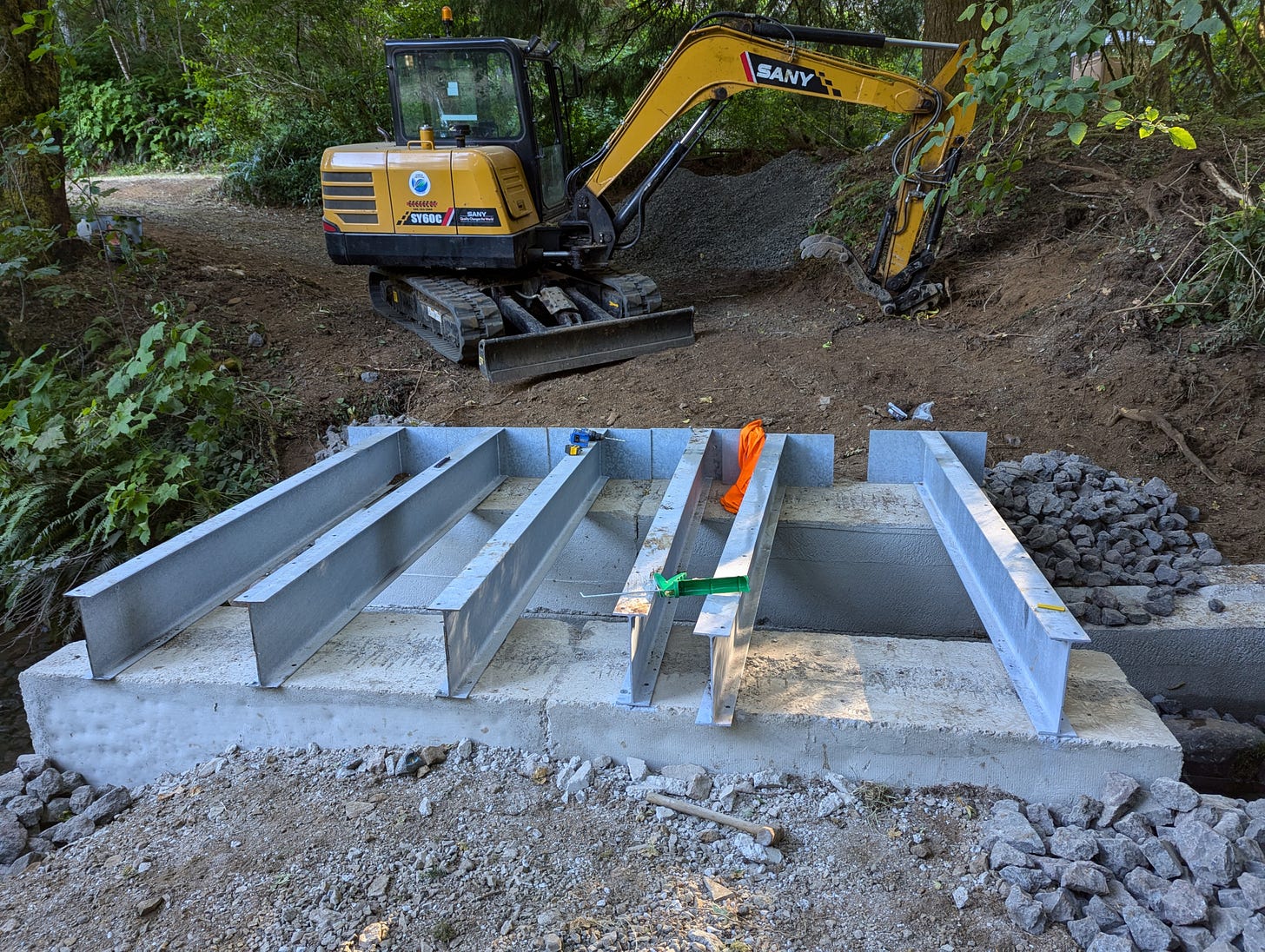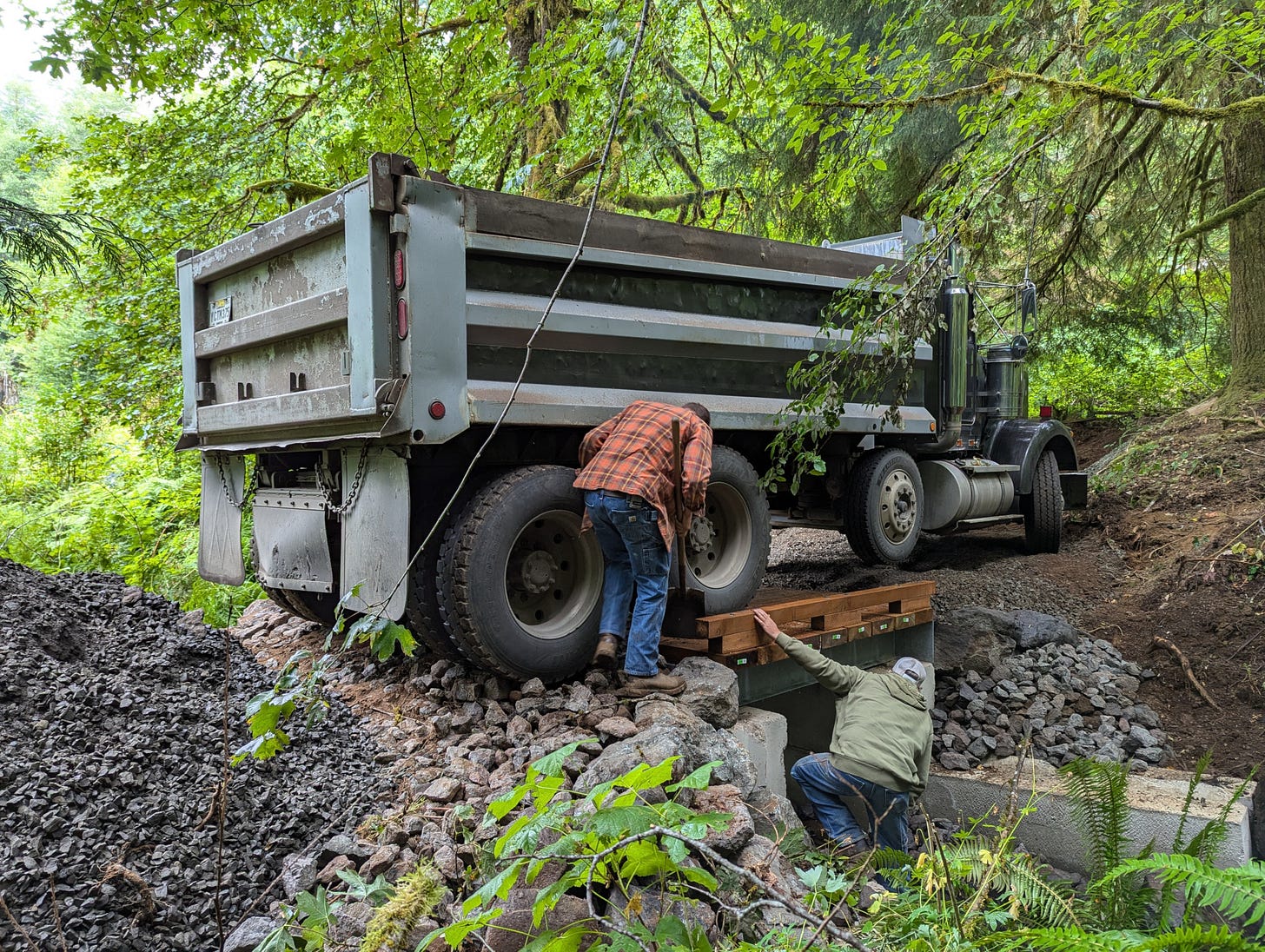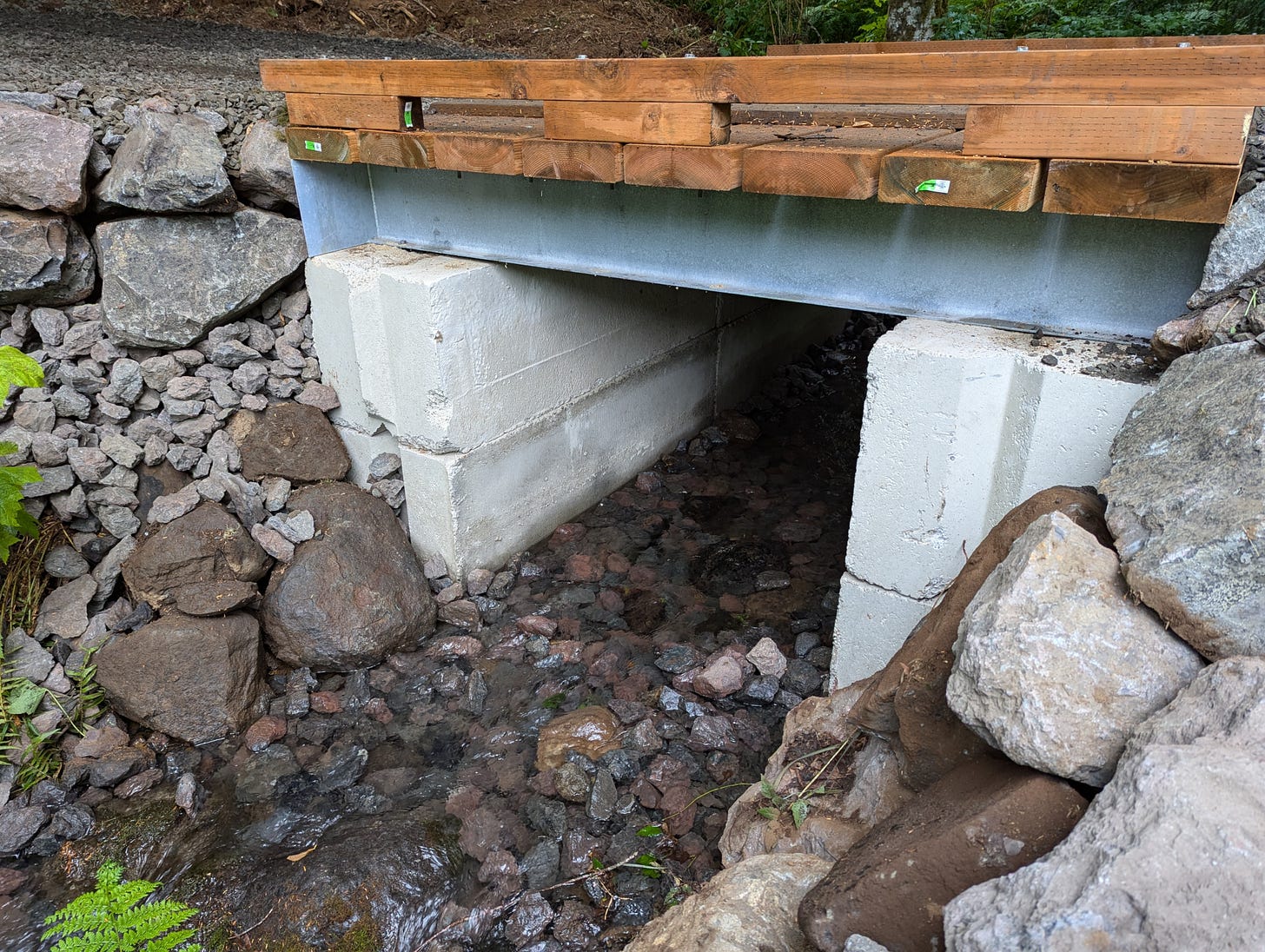Dear Everybody,
The driveway bridge is finished.
The epic saga, which at no point ran smoothly, has come to a conclusion. Both vehicles are parked where they belong (well, roughly, I need to make room in the garage for the truck). And the logjam which has delayed fully half of the projects I wanted to work on here is gone.
I’m going to recap how we got here, for anyone who hasn’t been following along. This post is kind of long, so you may need to click “view entire message” in GMail, or read it on the web (ThreeCreeks.substack.com).
Once upon a time (in September of 2022), about two days before the roofing company was to show up to replace the roofs on all the outbuildings, I was talking with my uncle Conrad. We were getting ready for a major job, with a large crew and two dump trucks, replacing over 3,000 feet of roof. I commented that it was a good thing the little 10' bridge that crossed the creek was in such good shape. He muttered that we didn't really know that for sure—no, he hadn't rebuilt it in the early 80s while he was living here, he had just put new surface boards on the existing structure. Yes, it probably did date back to the mid-30s when the house was built, from what we knew.
So after he left, I put on my water shoes and waded into the creek that runs between the upper driveway (the old county road) and the lower driveway that leads to the house. I peered under it to get a feel for the supports, and while the beams running across looked sturdy and sound, in all their creosote glory, and the bank they rested on looked stable, what was shoring up the bank at the water line was two 30" cedar tree trunks. One of them was mostly intact, but the other was eroded out to a mere shell, and looked like it could crumble at any time. I took a deep breath, looked at how dry the bank was (dry soil is unlikely to slide) and called the roofing company to caution them to drive across it only when necessary, and take it as slowly as possible. They did that, no disaster happened, whew.
Since it had weathered two laden dump trucks a few times, I kept using it myself, creeping my relatively light vehicles across. Then the rains came, and the ground was saturated. I started parking at the end of the upper driveway, and wheelbarrowing groceries and other supplies down the relatively steep curve, across the old bridge, and down. It's about 200 feet from there to the house, which is a trudge in bad weather, but oh well. Meanwhile, I was calling contractors, who ran me around ("We're structural engineers, we don't do waterways... talk to this civil engineering firm" "Oh, we're civil engineers, we don't do structures like bridges, talk to this structural engineering firm") (yes, they referred each other) and then told me it would take at least 18 months to get permits, it might have restrictions if it’s a fish-bearing stream, we’d have to talk to six different agencies, it would be a massive PITA... in other words, "we don't want this one". I talked to the Department of State Lands, the Department of Fish and Wildlife, and the Army Corps of Engineers, downloaded permit applications, and tried to puzzle out the regulations myself… and then the major rains arrived and stopped everything dead while the creek flooded.
The next April, I called Jevon, the contractor who fixed our septic tank when no one else would—remember when my aunt and I were coping without toilets for five months?—and asked him to take a look. He said sure, his crew could build a bridge, what permits were we going to need, again? I handed him everything I had been told by the agencies: it was probably going to be a routine maintenance permit, there were no fish involved, there shouldn’t be any other complications. Great!
Then State Lands told me I should talk to the fire marshal, since this is also the ambulance and fire department access for the house. So I talked to the deputy state fire marshal, who has jurisdiction all the way out here. According to him, the bridge needed to be engineered to 75,000 pounds for any emergency services to even try it. Which meant we couldn't just put up a wooden bridge and call it good.
So I called the structural engineers again, to ask for a bridge plan for this application. I got hold of a nice fellow who came out to have a look and take measurements, and he emailed me to say that he had just designed something nearly identical in Salem. He could adapt that plan and give it to us for about $3,000. I had been expecting something along those lines; the whole project started at $10,000 at the bare minimum, and if we’re going to do something this essential, we might as well do it right the first time. So I gave him the go-ahead, and waited.
And waited. He took nearly two months, sent it to my uncle instead of the contractor (this whole thing was plagued with miscommunications from start to finish), and we finally got it into Jevon’s hands. Jevon used it to file a permit application with Department of State Lands, and we were back to waiting again.
Months passed. I kept checking in, but DSL was backlogged thanks to staffing shortages. Eventually I nudged Jevon, who asked DSL, who said they were reluctant to issue the permit without more information. They were unsure about ODFW’s determination that this was not a fish-bearing stream (I’ve certainly never seen any vertebrates in it) and they wanted to have it re-assessed before the project was approved. If we could coordinate with ODFW and pay for the re-assessment—
Jevon put his foot down, consulted a lawyer, then re-wrote the permit application to emphasize that this was the only vehicular access to the residence, and that if anything bad happened while they were sitting on the permit application, and emergency services couldn’t get access to the residents, or the residents were stranded and unable to access their home because the bridge had collapsed, that they might want to consider the legal consequences…
Two days later the permit approval came back, and Jevon ordered the steel beams for the bridge supports.
The fabricator assured him that it would be a pretty quick job, just taking some H-beams (think I-beams, but better for this kind of load), drilling holes for the deck bolts, attaching flanges to the ends, and dipping it in galvanizing solution to prevent rust. The flanges would keep the gravel from spilling into the spaces between the beams and out into the creek. No problem, should be done in no time. That was at the beginning of May of this year.
You can probably see this coming.
Seven weeks later I nudged Jevon one more time, and he was obviously losing patience himself. The fabricator wasn’t answering his calls. He said he would lean on them. I don’t know what ensued, but a few days later he said that he expected to have the beams by the end of the week, or the start of the next week. For those of you who read the Summer Update, this was where we left off, and I was not putting the champagne on ice just yet.
In the very first days of July, he texted me to say that he had the beams at last, and he had put me on his calendar to commence work on July 9th. Again, I was cynical. But on Friday the 5th, a small earth mover appeared at the end of the upper driveway; I had moved the vehicles to get them out of the way, and there it was. The solution was starting to materialize.
On Tuesday, July 9th, there was a rumble of trucks at 7:30am, and the crew descended. I came out after breakfast to see that the old bridge was already gone (I discovered later it had simply been lifted out whole and set in the upper parking area). They were carving out space for the concrete blocks that would support the new structure, and damming up the creek just upstream. They weren’t trying to block or divert the water; they needed a deep enough pool to set a small pump in. Since fire season was in effect, they had to stop work by 1pm, and leave a crew member behind with the pump and attached fire hose, to monitor the site for an hour afterward. So they broke off in the early afternoon, leaving a neat gravel pad on the downhill bank, and promised to come back in the morning.
The next day, my uncle showed up as the work was starting to get going, and we walked through the whole project. It was swelteringly hot, but the crew appreciated the cool breeze that always follows the creek. That didn’t help me when I found myself scything a path through long grass so that my uncle could cart boxes of books across the Bridge to Nowhere, but I gritted my teeth and got the full path cleared. The last incline to the mailbox was too much of a goat track to use with the hand cart, however, so there was a second, steeper path that headed straight up. Still, the little footbridge served well, and I’m glad I repaired it.
I collapsed for the next few days, having worn myself out with three days of clearing brush and hauling things around to give the construction crew some elbow room. They worked steadily, their large dump truck delivering a dozen 6x2x2 concrete blocks to serve as footings, and the promised steel beams. Tim, the dump truck operator, was a fun guy to talk to, and he was often idle as he watched the progress and waited for his next run.
Three days in, Jevon came to fetch me, and said we had a problem. I followed him out, and he showed me the uphill bank—they had been carving it out to make room for the blocks, and encountered a large rock. Very large. He said it could even be bedrock, and I agreed, having seen slabs of basalt on the bed of both creeks in several places. He couldn’t place the blocks where the plans specified, and said we had three choices: chisel out the rock; undo all the work on the other bank to see whether we could shift the bridge downhill a couple of feet; or cut the steel beams to make the bridge shorter. Which would I like to do?
I couldn’t take the time to consult my uncle, with the crew sitting there idle, and he wouldn’t have any better information than I did. I asked Jevon what he would choose. He said that hammering out the rock would be very expensive, and it might extend across the whole face of the bank there. If we backtracked, and tried to excavate more of the downhill side, there was a distinct chance we would just run into another ridge of bedrock there, wasting all that time and effort. Since water tends to carve channels over time, I conceded that was likely… and besides, I didn’t like making the stream bed off-center. So, he said, his choice would be to cut the beams shorter, and bolt the cut pieces back on, so we had shorter lengths doubled up in the middle with flanges on both ends. It wouldn’t take a lot more time, and it would make the bridge even stronger (being shorter, with doubled supports). After checking to make sure there would still be enough width for the creek—he said the old bridge had allowed it five feet, and that was what we would end up with now—I told him to go ahead.
Work slowed as they made the modifications. It slowed further as they started putting the deck on; the shorter span meant the 4x12s didn’t come out evenly, so Jevon spaced them at an inch rather than half an inch. But that meant the pre-drilled holes didn’t match up. They drilled new ones, but the battery-operated hammer drill took time to recharge. I offered an outlet, 150 feet away, and suggested an extension cord, but it was coming up on the end of the day and Jevon said he’d figure something out. When they wrapped up, the deck was missing one board at the downhill end, but it could otherwise be used. Not driven on, as it was two feet above the surface of the old driveway, but it could be walked on with a little care.
Jevon told me that since the project had run long thanks to the modifications, he had run up against another job on his calendar. We had used the planned seven day window, making it Tuesday the 13th, and he had to go work on that other commitment for the rest of the week. He said he would be back in eight days, on Thursday the 22nd, and he’d be able to wrap it up by the next weekend. He apologized for the frustration; I said I was well past frustration by that point, and even past patience. Looking at it later, I decided I was simply resigned. I laid down two spare planks over the bare steel beam ends, set a chunk of old 6x6 in front to act as a step, and spent the next week with the car and truck still parked out at the road, coaxing Cricket over the dais that was serving as a bridge.
Thursday the 22nd came, and went, with no sign of movement.
Friday I was woken at 7:30 by the sound of trucks, but when I went up after breakfast, I found the earth mover, its trailer, a pickup, and not a soul in evidence. I took a nap around 2pm, and woke past 6. Walking Cricket that evening, I discovered that a little progress had been made—the last deck plank had been applied, and the treads and side rails had been laid, but not finished, with a few bolts sticking up several inches and a couple of boards still missing. I shrugged and kept waiting.
Monday morning brought Jevon, a helper, and Tim with his enormous dump truck. Jevon explained that when he showed up on Friday and set to work, his hammer drill had promptly died with a puff of smoke and stalled everything. But he had brought a new one, and they would get the job done pretty rapidly. It was drizzling, the fine misting rain that people from the Northwest learn to ignore, and as a result they didn’t need to follow fire season restrictions. They worked past 5pm, dropping load after load of crusher and gravel and smoothing it out. The first test of the bridge was the dump truck, full of gravel, backing across it to drop the load on the downhill side; as the wheels eased onto it, the bridge didn’t even creak. Jevon inspected it, declared that the truck had pressed the treads firmly onto the deck, and after snugging the bolts down again it should be good to go. The hex bolts were indeed protruding a little; tightened down, they sit on the surface of the treads, offering sparse studs to help with traction in rain or ice. Remembering how I had performed a banana-peel slip on the treads of the old bridge a couple of times, I think that is not a bad thing.
By the time they went home on Monday, there was a graveled slope leading down to the bridge, and a matching one on the downhill side. I happily fetched the car down from where it was parked at the road culvert—I had spent most of the day laboriously clearing the Bug Bay, and I tucked the Accord into place with a sigh of relief. Then I went out to where the truck was parked on the shoulder, well out of the way of the gravel trucks and log trucks barreling down toward the curve, and brought it down as well. I’m told that the truckers had been using it as a landmark on CB for the last couple of weeks.
Tuesday, the 30th, Jevon came with a young assistant to put on the finishing touches. They raked the gravel smooth, eliminating the tread tracks from the earth mover. I came out to find them digging holes for the new gate posts. Originally I had wanted the gate to be at the end of the new bridge, to make it harder for people to simply come down to the house, load up their truck with tools and ladders and such, and drive off. (I’m still replacing stuff that was stolen in 2020.) But the height of the new roadbed made it difficult to place the posts on the sloping gravel shoulders. After some thought, I asked Jevon to put them at the top, right where the driveway splits off to head down the curve to the bridge. I’m pleased with the location, but while the downhill 6x6 is set about three feet into the ground, the uphill side involved digging through packed stone, from a roadbed over a century old, and we gave up just shy of two feet deep. It should be fine, and if it isn’t, I have trees to tie it off to.
With the gate posts set, they were done…. with one exception. I had asked Jevon earlier how hard it was to move the old bridge. He said not too hard. I said, what about moving it down to the front lawn next to the driveway? He said, oh. Hmm. It wasn’t too hard to shove, apparently, but getting it down the curve and across the new span would take some doing. He muttered about putting it on the equipment trailer, and I left him to think about it.
So now he drove the earth mover over to it, and nudged it around. Several rounds of discussion between the three of us followed. Finally he wedged the bridge between the blade and the tip of the arm and lifted it… and it lifted him. The earth mover was on the tips of its treads, able to move, but only barely.
With some more finagling, we got the bridge shoved up on top of the blade assembly, and he brought it up about 10” off the ground with everything level. He sidled around a little, getting a feel for it, and said he was willing to take it down the curve. We might scuff the rails of the new bridge a bit, and we’d have to rake the gravel again… I said do it. So he carefully, slowly, backed up. He floated it all the way down, across the new bridge, very slowly. And then he slewed around, crept forward, and placed the old bridge under the Norway maple at the edge of the front lawn. One beam fell off, and was nudged to the side, but the rest of it held together fine. And that was that.
I figure I can slap a couple more treads on top to create a fully level surface and use it as a tent platform. It’s really nice to have something to set a tent on that isn’t uneven, cold, and damp. It should give purpose to a structure that may not be able to handle vehicles for another eighty years, but can certainly handle the weight of people and bags.
After that it was just packing up. While they hooked up the trailer and loaded the earth mover, I fetched some Martinelli’s from the fridge and brought it up with a few cups. They were happy to stay a few minutes to drink a toast to the completion of the project. Jevon said he’d be back after the rains start, to check on how it’s settling in, and he wants to stop by every so often after that. I told him he was welcome any time.
It’s been a week, and I have made a full grocery run (no calculations about how much I’ll have to haul down to the house, or whether it’s worth lugging the cooler) and loaded up the truck with lumber from Lowes. I have enough supplies to jumpstart about five projects now, and pretty soon I’ll begin hauling trash away to give myself more space. The waiting is over, and the only question is what to tackle first. There’s a lot to do.
Locals are welcome to come by and look at the shiny new bridge themselves—it’s tiny, smaller than you might think, even from the pictures. But it’s the most important 8 feet 3 inches on the property, barring perhaps the house itself. I feel confident that it can stand up to anything that lays wheel or tread on it, and will last for a century or more. You can find more pictures in the Google photo album.
Now that this major source of stress is finally resolved, if you want to help me out with another one, I’m putting together a wildfire evac kit for the cats. Carriers aren’t enough if we can’t return to the house for a week or more, so I want to buy folding crates for both of them, with litter boxes and food/water bowls. Chewy can set me up, but I could definitely use a little help with the cost. Please visit my Ko-fi page if you want to chip in to keep them safe and comfortable for years to come.
My next scheduled update is on the equinox, in late September. Tune in to see just how much of a difference a bridge makes!
—Sam



